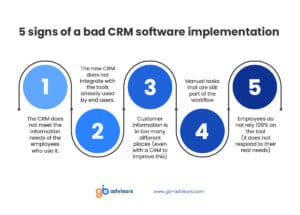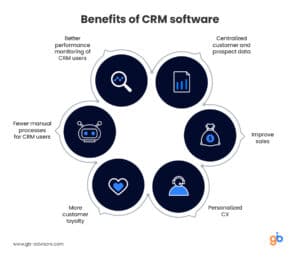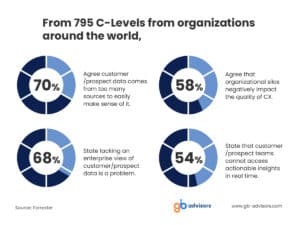Does implementing CRM software guarantee operational improvement in the organization?
The short answer is no, but this is not related to the software itself. This has more to do with the way of implementing the software.
Why? Because of the different variables involved in this process.
Not keeping this in mind will compromise the success of the initiative.
What are these variables?
- The specific characteristics of your organization.
- The human element (end users of the tool).
For example, what would happen if you don’t consider the specific nature of the company when implementing software?
What operational needs would the software be addressing then?
If you cannot answer these questions, it is possible that the system does not respond to existing needs.

On the contrary, this implementation will bring a myriad of operational problems. As a result, the investment will become a waste of money for the organization.
It will also represent an additional energy expense for the employees destined to benefit from it.
Below, we will explain the consequences of a bad CRM implementation.
In addition, we will explain in detail the most common mistakes when implementing CRM software.
What are the consequences of a bad CRM implementation?
Among the many consequences of a bad CRM software implementation, we can highlight the following:
Poor customer loyalty
A poor implementation of CRM software can result in an inability to detect and address your customers’ needs. In the long run, this can lead to your customers deciding to do business with a competitor.
Bad employee experience
Implementing CRM software incorrectly difficult customer information management. Moreover, the productivity of your employees may decrease (more manual tasks, new software hindering an already established workflow, etc.).
To avoid these problems, you must avoid the following mistakes when implementing CRM software.
3 common mistakes when implementing CRM software
1. Leaving the project entirely in the hands of the IT department
Nowadays, the role of the CIO and the IT area in organizations has transcended.
It is no longer enough to ensure the maintenance and evolution of a company’s digital infrastructure.
For example, through ITSM (IT service management), the IT area seeks to serve the organization’s goals.
On the other hand, through IT operations management (ITOM), the IT area must take care of the infrastructure and all operations of the company in the digital environment.
What does this mean? , through ITOM, IT is directly involved in business continuity if a catastrophic event (a cyber-attack, for example) occurs.
Here lies the importance of IT for the organization’s business environment…
Now, does the IT area know the customers and market to implement CRM software that sales, marketing, or customer service will use?
Although there may be exceptional cases, the IT team usually lacks context in these areas.
As a result, they may fall somewhat short when implementing and configuring the tool to the specific needs of the area that will use it.
In this sense, nothing beats the perspective of the end users.
What is the result of this mistake for your organization?
The CRM won’t respond to the needs of the department that will use it.
Employees will spend more time collecting, recording, and searching for information.
The tool may become obsolete for the team that will be using it.
All this translates into one thing: zero return on investment.
Is there a way around all this?
The solution to avoid this lies between the lines: end users must collaborate with IT in each implementation and configuration stage.
By doing this, you will ensure that the tool responds to the real needs of your end users. In the end, this helps you to secure the ROI of your investment.
2. Underestimating the challenges of data integration to the new CRM
We have already seen the importance of collaboration between IT and end users when implementing CRM software.
Now, let’s look in detail at a consequence of the previous point: data integration failures.
Underestimating data integration into the new CRM can, at the very least, complicate the work of the people who will use it.
What is the purpose of investing in a CRM if not to:
- Facilitate access to customer information for employees.
- Centralize information management
- Automate associated processes

In this sense, data integration into the new CRM goes hand in hand with its native ability to integrate with other tools.
In a Forrester study in which around 1,400 CRM users were consulted, 72% stated that a good integration capability in a CRM is vital for its effectiveness.
This streamlines workflows and reduces the friction of having a new tool. In addition, it also makes it easier for end users to adopt by easily integrating existing data into the new system.
On the other hand, having access to all existing customer and prospect information will help improve the quality of sales and marketing strategies; this will be possible because actionable insight will be a couple of clicks away.
Is there a way around all this?
The solution to this mistake lies in the first item on this list.
If the IT team is nurtured by the CRM end users’ perspective, the integration of the new tool with the old software will be easier.
End users can give the IT team perspective on which data needs to be integrated, and which can be left out and discarded from the configuration.
With this, any data in existing tools (such as a help desk or even CRM, for example) can be repurposed when integrated into the new CRM.
In this way, the employees who will use the tool will have the data they need from day 1.
3. Not expanding the use of CRM beyond sales and marketing
According to Forrester, one of the biggest challenges in CRM software adoption in companies is its organizational misuse.
What do they mean by this?
Here we are not referring to the use given by a specific area.
By this, we are referring to the use given to CRM on an organizational scale.
When an organization focuses on implementing CRM software in a particular area, we exclude the rest of the organization from this “source of information”.

This makes customer information less visible to other areas of the company. As a result, it will be harder to provide a consistent experience throughout the customer lifecycle.
Not having a detailed view of prospects and customers across the organization is a growing challenge for those responsible for technology investments in organizations.
This is not to say that it is mandatory to invest in a CRM for multiple areas to use.
However, it does infer one thing: the more areas, teams, and processes across the organization that share information from the CRM you use, the greater the return on investment you will get.
Is there a way around all this?
The solution to this mistake may seem simple: invest on a large scale so that the organization can use the same CRM.
However, this will depend on the size of the company planning to make the investment and your goals for the investment.
If your strategy is to improve your customers’ experience across their entire customer journey, you can try using CRM in a specific area and then expanding it to more strategically related areas.
Why implement CRM software throughout the organization?
You can quickly and accurately detect and address your customers’ needs.
Also, you will increase the effectiveness of your marketing and sales efforts (better sales and loyalty numbers).
On the other hand, a better customer experience during each stage of the customer journey gives you a better chance of building customer loyalty and repeat business.
Does this ensure success when implementing CRM software?
These are not the only mistakes you can make when implementing CRM software in your organization. However, they are three of the most important ones.
The success of any software implementation in an organization lies mostly in its implementation.
This is because it is at this stage when the tool is tailored to the particular needs of the area that will use it.
Without this, it will be difficult for end users to take full advantage of the tool from the beginning.
Moreover, this can throw away the investment made in the medium term. Why? If problems resulting from poor implementation are not addressed, users may be motivated to continue working as usual.
As a result, inefficiencies and problems that the implemented CRM software was intended to solve will be perpetuated.



